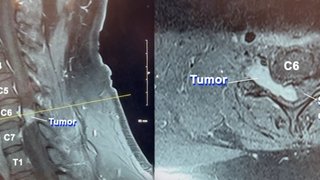Sciatica in pregnancy: When it's more than the usual aches and pains
January 14, 2025

Back pain is one of the most common symptoms of pregnancy, particularly in the second and third trimesters. Some discomfort is normal as the belly expands. But when pregnancy-related back pain manifests as electric tingles that zap from the lower back to the ankles, it’s not “normal” – it may be a painful nerve condition called sciatica.
The condition is named after the sciatic nerve, which starts at the base of the spinal cord and runs down the back of each leg. The sciatic is the largest nerve in the body, and it controls our ability to walk, sit, and stand.
With sciatic pain, you may feel a sharp or prolonged sensation of burning or electrical shock, as well as spasms, tingling, numbness, or weakness in your leg or foot. It might get worse with sudden movements like coughing or sneezing.
Sciatica is diagnosed in about 1% of pregnant patients, but the prevalence is likely higher since mild cases may be overlooked as “normal” back pain in pregnancy. The risk of sciatica increases if you have a history of spine or back problems such as a herniated disc, injury, or a musculoskeletal disorder.
For many women, sciatica resolves after giving birth. While there is no cure for sciatica in pregnancy, a pregnancy care provider can help you find strategies to manage symptoms and reduce the risk of long-term nerve damage.
Why pregnant women are at risk for developing sciatica
Like many other pregnancy symptoms, sciatica can be caused by hormonal changes. The hormone relaxin, for example, prepares your body for delivery by loosening the tendons and ligaments in your joints (including all the way down to your feet).
Pregnancy also shifts your body’s center of gravity. As your belly grows forward, the curve of your spine becomes more pronounced as your body tries to distribute the weight and keep everything in balance.
Both situations can put pressure on your sciatic nerve. During the second and third trimester, the position of the fetus can compress the nerve even further. That’s when the pain may escalate from annoying to unrelenting.
Related reading: Top symptoms patients might not expect during pregnancy
How to treat sciatica and other pregnancy-related pain

In most cases, no imaging tests are needed to diagnose sciatic pain in pregnancy. Your obstetrician will conduct a physical exam and ask specific questions about when your symptoms started, how and where the pain is progressing, and whether you’ve noticed any activities that seem to trigger or relieve the pain.
To keep the pain in check, your doctor may give the OK for a pregnancy-safe dose of acetaminophen (Tylenol). Avoid nonsteroidal anti-inflammatory medications (NSAIDs) such as ibuprofen and naproxen, as these can cause kidney problems in your growing baby. A heating pad and cold packs can be effective for some women.
The best treatment is often physical therapy. A licensed physical therapist will guide you through pregnancy-safe exercises to stretch and strengthen your core muscles safely. Aquatic therapy and massage therapy can be helpful as well.
In addition to guided sessions with your therapist, you’ll also learn how to safely exercise at home and get tips on adjusting your posture, daily movements, and sleep positions to minimize symptoms throughout the day.
When you’re able to move more freely again, you’ll need to be vigilant about avoiding back pain triggers like lifting or moving heavy objects, sitting on hard surfaces, and sitting or standing in one position for more than a few minutes.
One issue you shouldn’t be concerned about is the impact on your labor, delivery, and post-partum recovery. During labor and delivery, your body will take over, and your brain will focus elsewhere. After your baby is born, there’s no longer the physical pressure on your sciatic nerve, and your hormones eventually return to pre-pregnancy levels.
Tips to prevent pregnancy-related sciatica

While you can’t fully prevent any kind of back pain during pregnancy, you can minimize your risk by managing your wellness and fitness before conception and during the first trimester. Maintaining a healthy weight is important, and workouts should focus on improving the stability, flexibility, and strength of the core muscles in your abdomen, back, and pelvis.
Low-impact regimens such as yoga and Pilates typically cover all these areas. If you’re working out at home, some of the most recommended pre-pregnancy and early prenatal exercises include pelvic tilts, wall pushups, leg raises, and squats with a fitness ball.
Remember, discomfort is normal during pregnancy, but pain is not — there are safe pain management options, and you don’t have to “just live with it.”
To talk with a pregnancy care provider, call 214-645-3838 or request an appointment online.











